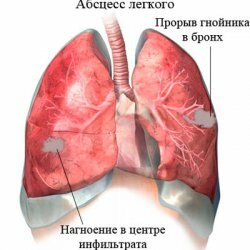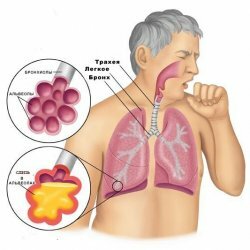Lung abscess

Causes of lung abscess disease
Lung abscess can occur when infected with various pathogens. The causative agents of the abscess are gram-negative aerobic bacteria, Staphylococcus aureus. They penetrate into the lung cavity by a bronchogenic route.
The inflammatory processes occurring in the oral cavity, as well as in the nasopharynx, for example, periodontal disease, tonsillitis, may also be the cause of the disease. Complications of these processes can lead to abscess of the lungs.
Lung abscess can also be caused by aspiration of vomit or foreign bodies. These foreign bodies clog the bronchus, thereby depriving the lungs of an influx of air. In this case, there may be an abscess.
More rarely, the cause of this disease is hematogenous infection.
When a lung infarction occurs due to embolism, secondary bronchogenic infection is possible.
Classification of lung abscesses
Depending on the pathogens abscesses are: bronchogenic, hematogenous, traumatic.
Depending on the location of the abscesses are classified: peripheral and central, multiple and single. Also, the abscess can be located in one lung. There are also bilateral lung abscesses.
Depending on the development of abscesses are acute and chronic.
Risk factors for lung disease
The risk group is made up of people with a disease in which there is a high likelihood of purulent inflammation. There are also factors that reduce the protective functions of the body. These include drugs, alcoholism, vomiting, diabetes and others.
Symptoms of the disease with abscess of the lungs
The disease passes in two periods. The first period is the formation of an abscess. The second period is an autopsy of the purulent cavity.
In the first period the patient feels severe pain in the chest area. This pain intensifies during breathing and coughing, fever, difficulty breathing, weakness of the body are possible. The onset of the disease is accompanied by a dry cough, shortness of breath, a strong increase in body temperature. However, in some cases it happens that the clinical manifestations and symptoms are very mild. When the disease develops, the symptoms increase. Nausea, loss of appetite, headache intensifies, general weakness of the body is observed. Visual examination of the patient shows that part of the chest, which has an affected lung, lags behind when breathing. With a bilateral lung abscess, the thorax moves asymmetrically. This period of the disease lasts about 7-10 days.
Opening of the purulent cavity and outflow of its contents occurs during the second period. In this case, the cough becomes more moist and coughing up begins. Within a day goes to a liter and more purulent sputum. All this depends on the volume of the cavity. In the second period, the symptoms of the disease decrease, the patient feels better. By analysis of the blood, the fading of the infectious process becomes evident.
Complications of the disease
Pulmonary abscess can lead to serious complications. It can be purulent pleurisy, pyopneumothorax, pulmonary hemorrhage. Infection also can spread to a healthy lung and form a lot of abscesses. If the infection spreads hematogenously, then abscesses can form in other organs and tissues. All this can result in a bacteremic shock. A high percentage of lethal cases with abscess of the lungs.
Diagnosis of abscess of lungs
For the diagnosis of an abscess, a general blood, urine and stool test is prescribed. In the analysis of blood, leukocytosis is clearly expressed, and a shift in the leukocyte formula and the toxic granularity of neutrophils are also observed. There is a high level of ESR, a decrease in albumin indicates the chronization of the process. The analysis of urine shows cylindruria, microhematuria and albuminuria. The degree of severity of these changes will depend on the severity of the disease.
It can be prescribed to conduct a general sputum analysis, sputum smear with bacterosseum to identify pathogens and determine their sensitivity to antibacterial drugs. The most reliable study for establishing the correct diagnosis of "abscess of the lungs" is the radiography of the lungs. It will also help distinguish abscess from other bronchopulmonary diseases.
In order to confirm or rule out the complications of lung abscess, pikfloumetry is prescribed. If there are suspicions of pleurisy, pleural puncture should be performed.
Treatment of abscess of the lung
The earlier the treatment is started, the more successful it is. The severity of the disease will determine the tactics of his treatment. With pulmonary abscess, both surgical and conservative treatment is possible. Treatment is carried out only in a hospital, in the pulmonology department. However, an important point in the treatment of abscess is to provide the patient with a constant supply of fresh air. In some cases, oxygen inhalation may be prescribed. Also, special attention should be paid to strengthening the body's defenses. For this patient needs to provide high-quality food, foods rich in proteins, fats, carbohydrates. The diet should include vitamins, mineral salts.
Conservative treatments for abscess include strict adherence to bed rest and giving the patient a drainage position a couple of times a day. This is necessary to improve the outflow of phlegm. It must always be remembered that a patient may have a large amount of sputum. Therefore, it is necessary to watch closely the patient at night, so that the sputum does not cause a violation of breathing. That this did not happen, it is better that the head of the patient was turned to one side. With abscess of the lungs, antibacterial therapy is immediately prescribed. Having determined the sensitivity of microorganisms, it is possible to carry out correction of antibiotic therapy. To conduct a reactivation of the immune system, the doctor prescribes autohemotransfusion and blood transfusion. According to the indications, antistaphylococcal and gamma globulin are prescribed.
If natural drainage does not help, then bronchoscopy with active cavity aspiration is performed. They are washed with solutions of antiseptics. It is also possible to inject antibiotics directly into the cavity of the lung abscess. With a peripheral location and a large size of the abscess can resort to transthoracic puncture.
If conservative treatments for abscess disease are ineffective or complications occur, then a lung resection is prescribed. This means removing part of the lung.
Forecast for
If the disease does not take a long or complicated course, then the recovery may occur after 6-8 weeks.
Prevention of the disease
Specific prevention of such a disease as a lung abscess does not exist. Nonspecific prevention of pulmonary abscesses is the timely treatment of bronchitis and pneumonia. An important aspect for reducing the incidence of lung abscess is also the fight against alcoholism.



